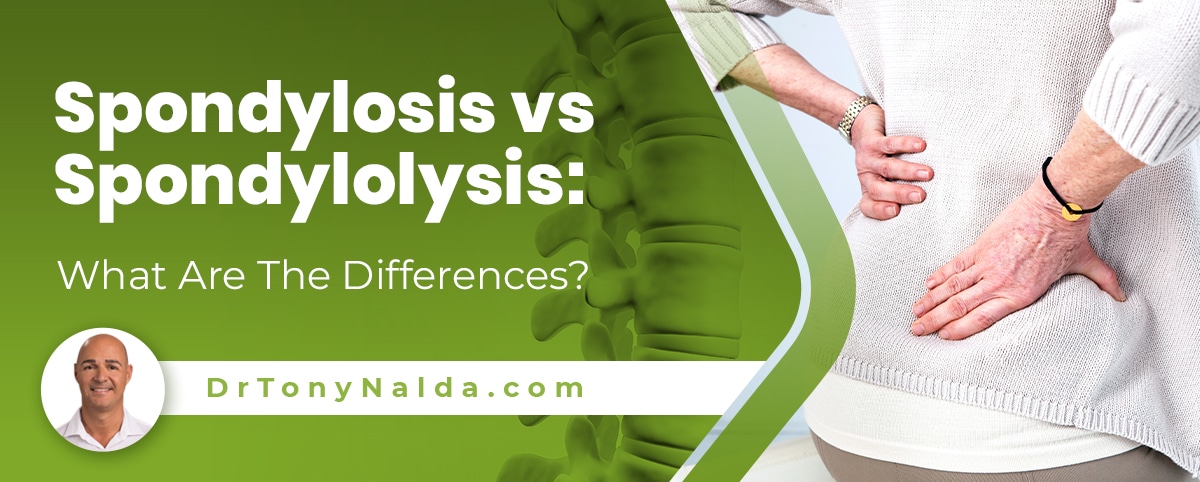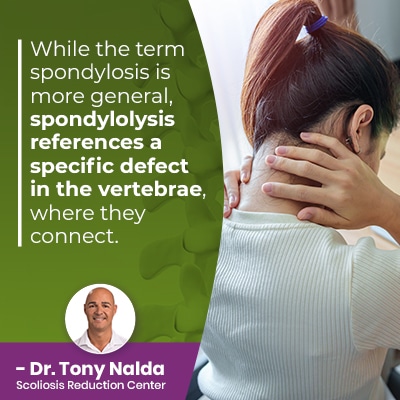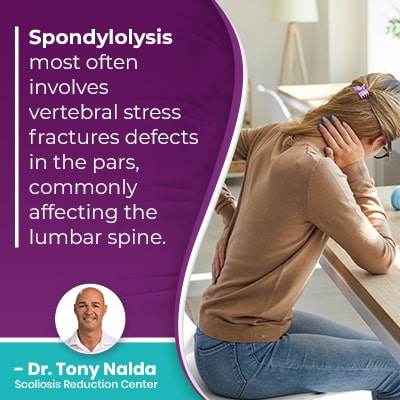Spondylosis vs Spondylolysis: What Are The Differences?

The body degenerates with age, including the spine. Spondylosis is not a condition itself, but refers to general spinal degeneration, often caused by arthritis and/or degenerative disc disease; spondylolysis references a specific injury that commonly involves the facet joint.
There are a number of spinal conditions/issues the spine is vulnerable to developing. Spondylosis refers to general degenerative changes within the spine, most often arthritic, while spondylolysis involves a defect in the pars interarticularis of the vertebrae, often caused by an overuse injury.
Let's start our explanation of the differences between spondylosis vs spondylolysis by first touching on some basic spinal anatomy, for a better understanding of how degenerative changes can affect the spine.
Table of Contents
Anatomy of the Spine
When talking about issues related to spinal degeneration, it's important to understand the spine's basic structure.
The spine consists of vertebrae (bones of the spine), stacked on top of one another in a straight and neutral alignment, and there are three main spinal sections: cervical spine (neck), thoracic spine (middle/upper back), and lumbar spine (lower back).
In a healthy spine, the vertebrae are rectangular in shape; facet joints connect the bones of the spine, and spinal nerve roots originate from the spinal cord.
Each individual vertebral bone has a pars interacticularis (pars, for short) as part of its facet joint, and facet joints are key structures when it comes to the development of spondylolysis, which we'll explore more later.
Natural and Healthy Spinal Curves
When a healthy spine is viewed from the front and/or back, it will appear straight, but when it's viewed from the sides, it will take on a soft 'S' shape, and this is due to the spine's natural and healthy curves.
The spine's healthy curves make it stronger, more flexible, and better able to absorb/distribute mechanical stress incurred during movement.
In order for the spine to function optimally, its natural curves have to be maintained, and there are a number of spinal conditions/issues that involve a loss of the spine's healthy curves.
When the spine loses one or more of its healthy curves, the spinal nerves are affected, along with the biomechanics of the spine, which affects how it functions, and its overall health.
Intervertebral Discs
The vertebrae of the spine are separated by intervertebral discs, and particularly when it comes to the type of spinal deterioration involved in spondylosis, the discs are important because they're often the first spinal structures to show the effects of spinal degeneration.
The intervertebral discs have two main parts: a soft gel-like interior, known as the nucleus, and a tough durable outer layer, its annulus.
The spine is also vulnerable to natural age-related degenerative changes, such as in the development of degenerative disc disease, so let's move on to defining a spinal issue involving deterioration: spondylosis.
What is Spondylosis?
Spondylosis is not a clinical diagnosis, and more so references general spinal degeneration, without specifying the location, type, or cause of degenerative changes; thus, spondylosis can have a number of causes, the two most common being arthritis of the spine and/or degenerative disc disease.
Arthritis of the Spine
Osteoarthritis is the most common type of arthritis, and when it develops in the spine, it can cause a loss of space between each vertebral body, caused by the wearing down of the protective cartilage found on the ends of the vertebrae, and this can also cause compression of a nerve root nearby.
It's the protective cartilage that helps prevent friction caused by vertebrae rubbing up against one another during movement, which increases spinal wear and tear.
Spinal degeneration tends to increase with age, particularly for women who are vulnerable to hormone and bone-density changes related to menopause.
People with degenerative osteoarthritis might develop a pitched-forward posture and experience lower back pain, leg pain, and/or tingling sensations related to compression of the spinal nerves, and is known to cause radicular pain felt in the extremities; in these cases, treatment options include pain relief.
Degenerative Disc Disease
Degenerative disc disease is associated with spondylosis because the spinal discs are essential to the spine's function, health, structure, flexibility, and act as its shock absorbers.
Most often, when a disc starts to deteriorate, it changes shape and loses height, often caused by disc desiccation, and this affects the position of adjacent vertebrae.
So spondylosis is more of an umbrella term referencing spinal degeneration caused by arthritis and/or degeneration of the spinal discs.
Now that we've explored the meaning of spondylosis, and some its primary symptoms and causes, let's now define spondylolysis.
What is Spondylolysis?
 While the term spondylosis is more general, spondylolysis references a specific defect in the vertebrae, where they connect.
While the term spondylosis is more general, spondylolysis references a specific defect in the vertebrae, where they connect.
Spondylolysis can develop anywhere along the spine, but most commonly affects the lower back that has to support the weight of the spinal sections above, and the entire weight of the upper body; in addition, the lower back feels the effects of bending, twisting, and lifting motions, while working hard to coordinate hip, pelvic, leg, and feet muscles and movement.
So if spondylosis is left untreated, or its underlying cause is undetermined, increasing spinal degeneration, and risk of injury, can cause the development of spondylolysis.
 Spondylolysis most often involves vertebral stress fractures defects in the pars, commonly affecting the lumbar spine.
Spondylolysis most often involves vertebral stress fractures defects in the pars, commonly affecting the lumbar spine.
In many cases, defects in the pars are related to repeated stress and/or trauma experienced by the lumbar spine; strenuous activities, sports, and movements that involve repeatedly twisting and rotating the spine that can cause a crack and/or stress fractures.
Certain activities that involve hyperextending the spine, as in gymnastics and/or dancing, can also expose the spine to uneven pressure, adverse spinal tension, and excessive wear and tear.
Some cases of spondylolysis are asymptomatic, while others can involve varying levels of back pain, particularly when bending forward during certain activities.
Age and Compression
If you've done much reading on spinal conditions, you will likely have come across the connection between age, compression, and pain.
Age is a significant patient factor when it comes to predicting how painful a spinal condition/injury is likely to be.
In younger patients with growing spines, those spines are experiencing a constant lengthening motion, which counteracts compressive forces: known to be the main cause of pain in many spinal conditions.
If a stress fracture injury is left untreated, however, and progresses, related symptoms tend to increase alongside condition severity, and severe pain can become an issue, sometimes necessitating the prescription of pain medications like nonsteroidal anti inflammatory drugs, facet joint injections, and/or epidural steroid injections to relieve pain.
So the connection between spondylosis vs spondylolysis is that patients experiencing spinal deterioration, regardless of its cause, are more vulnerable to spinal instability and future injury; the main difference is that spondylosis is a general term referencing general spinal degeneration, while spondylolysis refers to a specific injury caused by a structural defect in the pars of affected vertebrae (pars fracture).
Also, spondylosis is more closely associated with age-related spinal degeneration, while spondylolysis is most closely associated with adolescents participating in sports and activities that expose the lower back to repetitive trauma and repeated stress.
If a lumbar vertebra slips forward because of a stress fracture weakening it, this means the spine is no longer aligned and lumbar spondylolysis has progressed to becoming spondylolisthesis.
So if lumbar spondylosis is left untreated, it can become spondylolysis, and if that is also untreated, it can progress further to become spondylolisthesis.
Conclusion
When it comes to maintaining the spine's optimal health and function, it's about spinal alignment, biomechanics, and preventing the development of a number of spinal conditions.
Part of helping the spine maintain its natural curves and alignment is keeping the back and abdominal muscles strong so they can support the spine, and this can also help prevent future injury, muscle spasms, muscle weakness, a number of spinal disorders, bone spurs, decrease pain, and relieve pressure.
When it comes to spondylosis vs spondylolysis, we're talking about the difference between general spinal degeneration caused by arthritis and a specific injury commonly involving structures called facet joints.
Now, the connection between spondylolysis and spondylolisthesis is that if a stress fracture is left untreated, it can cause a slipped vertebra, and that slip forward can impact surrounding soft tissues and the verebra directly below.
Here at the Scoliosis Reduction Center, I have experience treating a wide range of spinal conditions, and through a variety of conservative treatments, I can help prevent the development of degenerative spondylolisthesis, spinal stenosis, reduce pain, work towards muscle strengthening through physical therapy so the spine is optimally supported, and prevent the need for surgical treatments in the future.
The reality is that many spinal conditions/issues will respond to nonsurgical treatment options; the answer doesn't have to be costly and invasive spinal fusion surgery as the integration of condition-specific chiropractic care, physical therapy, massage therapy, and the use of a corrective back brace can help the spine maintain its natural curves, alignment, and prevent further spinal degeneration.
Dr. Tony Nalda
DOCTOR OF CHIROPRACTIC
After receiving an undergraduate degree in psychology and his Doctorate of Chiropractic from Life University, Dr. Nalda settled in Celebration, Florida and proceeded to build one of Central Florida’s most successful chiropractic clinics.
His experience with patients suffering from scoliosis, and the confusion and frustration they faced, led him to seek a specialty in scoliosis care. In 2006 he completed his Intensive Care Certification from CLEAR Institute, a leading scoliosis educational and certification center.
About Dr. Tony Nalda
 Ready to explore scoliosis treatment? Contact Us Now
Ready to explore scoliosis treatment? Contact Us Now





